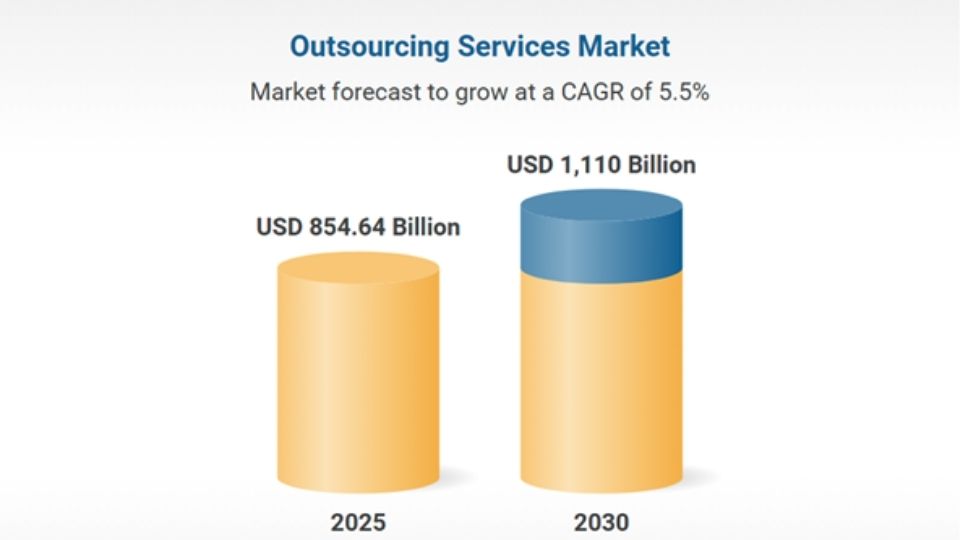In-House vs Outsourcing Software Development: How to Choose?
In-House vs Outsourcing Software Development: How to Choose?
KIMEI Global
3月 03, 2025
In-House vs. Outsourcing Software Development: Pros, Cons & Cost Analysis. Discover the Best Model for Your Business!
The outsourcing trend is rapidly growing worldwide, particularly in major markets such as the United States, Japan, and Canada. According to the latest report from Statista, the global outsourcing market is projected to reach an impressive $854.637 billion by 2025, a figure that underscores the undeniable appeal of this model. However, this does not mean outsourcing is the ideal solution for every business.
The decision between in-house development and outsourcing requires careful consideration of several critical factors. In terms of cost, while outsourcing can offer short-term budget savings, in-house development provides greater long-term control. Speed of implementation is another key factor—do you need a team that can start immediately, or are you willing to invest time in training? Notably, data security and quality control are always top priorities when deciding to outsource.
As an industry expert once remarked, “Outsourcing is a double-edged sword—if not carefully considered, businesses may pay the price in time, money, and reputation.” So, how do you determine which model In-House vs. Outsourcing Software Development—is truly suitable for your business? The answer lies in the discussion below.

In-House Software Development - The Optimal Solution for Mastering Technology
The Concept of In-House Software Development
The in-house development model is a solution that enables businesses to proactively build and manage software systems using their own dedicated team. With this model, the company owns a full-time, well-trained team that works directly under its management. This ensures that all technology development activities closely align with the specific requirements and business goals of the enterprise. Unlike outsourcing, this model offers numerous superior advantages. Let’s explore the benefits of this approach together.
Advantages of In-House Software Development for Businesses
Full Control Over Personnel
With the in-house development model, businesses gain complete authority over managing their technical team. This ensures that personnel not only possess the necessary expertise but also deeply understand the company’s culture. All development processes, from design to implementation, are executed in alignment with the established business standards and objectives, fostering seamless integration across the entire system.
Direct Communication and Support
One of the standout advantages of the in-house model is the ability to facilitate direct interaction. When issues arise, departments can communicate and collaborate immediately to resolve them without navigating multiple intermediaries, as is common with outsourcing. This streamlined workflow significantly saves time while enhancing efficiency in product optimization and development.
Deep Specialization
The in-house team is built to thoroughly understand every facet of the business’s operations. From specific business requirements and operational processes to unique technological needs, in-house personnel are equipped to deliver the most optimized solutions. Their ability to adapt flexibly and adopt new technologies is also seamless, without reliance on third parties.
Maximum Information Security
In an era where cybersecurity is increasingly critical, the in-house model offers a significant advantage in data protection. All sensitive data is tightly controlled within a closed system, minimizing the risk of information leaks. This is a pivotal factor in safeguarding intellectual property and maintaining a competitive edge in the market.
Limitations of Choosing In-House Software Development
With such remarkable advantages, does in-house software development have any drawbacks? Let’s explore them below.
High Operational Costs
According to a report from PayScale, the average salary for a developer in the U.S. is $72,000 per year—a significant expense for many businesses. Maintaining a team of five developers could result in personnel costs reaching $360,000 annually, excluding benefits and additional expenses. Notably, even when there are no active projects, businesses must still cover full salaries, placing considerable pressure on budgets.
Challenges in Retaining Talent
In the highly competitive technology market, skilled developers are constantly sought after by numerous companies. Retaining a high-quality team requires businesses to offer attractive compensation packages, an ideal work environment, and clear career advancement opportunities. Failure to meet these expectations increases the risk of losing key personnel, directly impacting project timelines.
Pressure of Training and Technology Updates
The IT industry is constantly evolving, with new programming languages, frameworks, and tools emerging regularly. To ensure product quality, businesses must invest time and money in ongoing training for their in-house team. This is not only costly but also demands long-term commitment from both the company and its employees.
These challenges highlight that in-house development is not an easy choice. Businesses need to carefully assess their financial capacity, long-term strategy, and ability to manage personnel before investing in this model. In many cases, combining a core in-house team with outsourcing for secondary projects may be the optimal solution in terms of cost and efficiency.

IT Outsourcing Software Development - A Flexible Solution for Businesses
The Concept of IT Outsourcing Software Development
IT Outsourcing Software Development is a model in which businesses engage technology providers in countries with lower labor costs but comparable or higher-quality talent to build and develop their software. This is one of the most popular models chosen by many international businesses today.
Advantages of IT Outsourcing Software Development for Businesses
Optimal Cost Savings
Outsourcing offers a highly cost-competitive solution for technology talent. Businesses from countries with high labor costs can save 40-60% of their budget compared to in-house recruitment. Beyond reducing base salary expenses, this model also significantly cuts costs related to benefits, infrastructure, and recruitment—ideal for long-term projects requiring tight budget control.
Access to Global Technology Expertise
Outsourcing breaks down geographical barriers, opening opportunities to collaborate with top experts worldwide. Businesses can select development teams from high-quality talent markets such as India, Ukraine, or Vietnam—regions known for their skilled engineers at reasonable costs.
Minimized Project Risks
With rigorous selection processes from reputable outsourcing partners, businesses are assured of the development team’s expertise. Outsourcing companies often adhere to international quality management standards (ISO, CMMI), minimizing risks related to project timelines and product quality.
Ensured High-Quality Expertise
Choosing outsourcing unlocks a global pool of technology talent. Partners provide experienced, well-trained engineers who regularly update their skills with the latest technologies. This ensures optimized technology solutions that meet even the most stringent client requirements.
Accelerated Time to Market
Unlike the lengthy process of recruiting and training in-house staff, outsourcing delivers a ready-to-work team that can start projects immediately. With professional workflows and diverse project experience, the time to bring a product to market can be reduced by 30-40% compared to traditional methods.
Limitations of Choosing IT Outsourcing Software Development
Challenges in Selecting an Outsourcing Partner
Finding a high-quality IT outsourcing partner is a significant challenge for many businesses today. The outsourcing market is vast, with countless providers, but not all meet stringent standards for workforce quality.
One of the biggest hurdles is the disparity in expertise among outsourcing companies. While some providers boast highly skilled engineers, others offer only average or inexperienced talent. Even when partnering with a company with skilled personnel, businesses may still face issues due to the partner’s lack of understanding of the target market—a critical factor for developing products that align with real-world needs.
This poses particular difficulties for startups or small and medium-sized enterprises in finding a suitable partner. A solution is to seek advice from industry experts or collaborate with reputable outsourcing consultancies to minimize risks during the selection process.
Cross-Cultural Communication Barriers
When working with overseas partners, differences in time zones, languages, and cultures can create significant obstacles. Coordinating tasks across time zones may slow progress, while language differences can lead to misunderstandings in technical requirements.
However, many leading outsourcing companies have addressed these issues by:
-
Providing teams proficient in English or the client’s required language
-
Establishing seamless task handover processes across time zones
-
Utilizing modern project management tools (e.g., Jira, Slack, Zoom) to enhance communication
Information Security Risks
Sharing sensitive data with third parties inherently carries risks, such as:
-
Exposure of customer information or trade secrets
-
Loss of control over intellectual property
-
Weak security systems at the partner’s end
Preventive measures include:
-
Selecting partners with international security certifications (e.g., ISO 27001, SOC 2)
-
Signing robust Non-Disclosure Agreements (NDAs) with legal binding
-
Implementing data access controls based on the “need-to-know” principle
-
Using end-to-end data encryption platforms
Major corporations like Google and Microsoft have successfully maintained outsourcing models through robust risk management strategies. The key lies in selecting the right partner and establishing transparent collaboration mechanisms.
KIMEI Global - A Trusted IT Outsourcing Partner in Vietnam
KIMEI Global is an IT outsourcing company based in Vietnam, specializing in delivering cutting-edge technology solutions to help global businesses bring their ideas to life and optimize operational performance. With a mission to be a reliable technology partner, we offer customized software development, AI integration, modern e-commerce website design, and comprehensive technology solutions tailored to meet the diverse needs of businesses in the digital era.
With over five years of experience collaborating with markets such as Japan, South Korea, Hong Kong, Taiwan, APAC, and North America, KIMEI Global confidently provides optimized solutions tailored to each business’s unique requirements. We specialize in sectors including E-commerce, Entertainment, Manufacturing, Supply Chain, HRM, Fintech, Travel, Education, Logistics, Beauty, F&B, and Retail. Our expertise spans multi-platform application development (PHP, JavaScript, Java, C#, Ruby, etc.), artificial intelligence (AI), blockchain, and IoT, enabling clients to enhance user experiences and drive revenue growth.

At KIMEI Global, we place people at the core, fostering a creative, flexible, and collaborative work environment. Our team of experienced engineers leverages advanced technologies and adheres to international standards such as Scrum/Agile and IEEE, ensuring every project is delivered efficiently, on time, and within budget. Let KIMEI Global be your partner in the digital transformation journey! We don’t just provide technology—we deliver innovation, efficiency, and long-term success. Contact us today at [email protected] or visit https://kimei.vn to discover how we can help your business thrive in the global market!

おすすめの記事